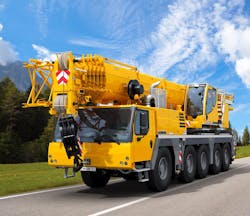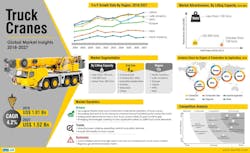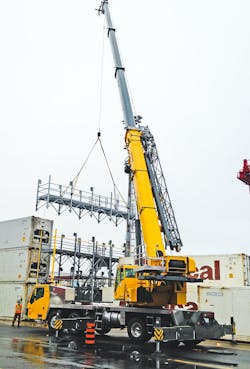Although truck cranes are not a high-volume product in North America, the market is good, and OEMs are touting lighter-weight units with versatility and ease-of-use features.
“The hydraulic truck crane market has been roughly 200 units annually for the past three years, from 2016 through 2018,” says Chuck Yengst, president of Yengst & Associates. “The estimated population of truck cranes in North America is about 10,000 units at the end of 2018.”
Yengst says that truck cranes are slowly giving way to other types of cranes, causing the market to decline in size. “However, sales will be higher in 2019 and 2020 in line with a strong economy,” he says. “Truck cranes are not going away and will be with us for a period of years regardless of erosion from other cranes getting preference. But the historic past, when industry sales topped 500 units annually in the pre-2010 time frame, is over.”
There are three primary OEMs in North America, Grove (part of Manitowoc), Link-Belt, and Terex, which was recently purchased by specialized equipment and trailer manufacturer Load King. Liebherr is also active in the North American market, but not to the extent it is in Europe.
“Grove is No. 1, with about 45 percent of the market,” Yengst says. “The other two suppliers have slugged it out for a number of years, with Link-Belt having second place in 2018 with about 30 percent of sales.”
Worldwide, according to Fact.MR, an Ireland-based research firm, the truck crane market moved beyond 9,300 units in 2018, and the market is projected to grow at over 4 percent CAGR through 2028 (see below).
Fact.MR’s study says that truck cranes with lifting capacity of less than 150 tons are the most popular, holding over 78 percent of truck crane sales in 2018. This demand can be attributed, the study says, to rising demand for compact-sized equipment and its greater transportability and easy maneuverability on job sites.
In terms of revenue, however, Fact.MR estimates that truck cranes with 300 tons lifting capacity are the leaders, with over $670 million in revenues for 2018.
J.J. Grace, product manager of GHC cranes at Manitowoc, sees a “very strong” market for his cranes. “The TMS9000-2 continues to be a very popular model among our truck crane customers,” Grace says. “It’s a lightweight crane with a long boom that offers excellent capacities. Also, with the release of our new 40-ton truck crane, the TMS500-2, we have continued to see the rise in demand.”
Grove launched its TMS500-2 truck crane in mid-2018. Through parent Manitowoc, 2018 also saw the debut of a free diagnostic smartphone app that enables truck crane operators to diagnose technical issues without third-party assistance.
“We believe the boom truck and truck crane market is expanding in 2019,” says John Lukow, SVP, cranes, for Load King. “Factors we observe are construction spending, the unemployment rate, the price of oil, a significant backlog in transmission and distribution work, and our own rental-fleet utilization.”
There are a number of factors to consider before investing in a truck crane. Size and configuration will dictate ease of transportability and set-up.
“Transportability is very important to consider when buying a truck crane,” Grace says. “Weight regulations can vary between states and municipalities, therefore we’re always working with our customers and dealers to determine the best crane and configuration to best fit their needs.
“Customers also need to take into consideration the load charts in taxi configurations,” Grace says. “Customers are looking to avoid taking a fall off load. When possible, maximizing our taxi configurations will further increase their return. On the TMS9000-2, we released a new counterweight configuration, the Heavy Roadable XL Package. This allows customers to carry up to 21,000 pounds of counterweight and stay under the crane’s maximum axle limitation.”
R&D Crane Rental, Burnside, Nova Scotia, Canada, was the first company in Canada to take delivery on a TMS9000-2.
“The main selling point for us was the longer main boom,” says Alex Jenkins, operations manager of R&D. “Other comparable cranes only have 142 feet of main boom, while this one gives us 169 feet. That extra reach has saved us hours on the job since we don’t have to take a swingaway jib on and off the crane.”
The crane recently worked on a Marriott-branded hotel in Halifax, Nova Scotia, where it was hoisting formwork panels at radii ranging from 140 to 150 feet.
Jenkins also credited the crane’s weight and 115-ton capacity with giving R&D an edge.
“The unit has a comparable gross weight to that of a lower-capacity crane, but you also get extra boom length. This makes it easier to get proper road permits in our region,” Jenkins says. “The crane has worked almost every day since we acquired it. It gives us the reach we need to adapt to a wide range of job sites.”
Load King’s Lukow also advises buyers to consider versatility.
“A crane is a significant purchase for most companies,” he says. “I think the most important factor to consider for a crane owner is if the crane can provide almost all your lifting needs with a full outrigger spread and a main boom with rigging that you can leave in place.
“It’s fine to have a jib and alternative lift plans for tight spaces, more parts of line, etc., but you want to have a crane that fits most your needs without those considerations. The rationale is just for ease of use and speed of set-up,” Lukow says.
“Configuring the crane for a special lift is more time- consuming and reduces the number of working hours the crane has available,” Lukow says. “You want to have the jib, a higher capacity block, and those mid-span and narrow outrigger spread charts to make your crane versatile, and to handle unusual situations.
“But good ROI is going to come down to having a crane that fits most of your situations in its standard configuration,” Lukow says. “This may let the operator complete more than one job in a day, increasing profitability and improving customer service.”
For operating-cost savings, manufacturers talk about control settings, fuel consumption, and utilization.
Grace points to his company’s CCS (Crane Control System) as a feature to help managers save money.
“All of our CCS-equipped cranes come with ECO mode,” he says. “The software detects the operators’ working habits and controls rpm based on specified settings. This helps to reduce fuel consumption, but also lowers engine noise while on the job site.”
The Crane Control System is a standardized user interface that provides a common operating platform across multiple product lines, which in Manitowoc’s case includes familiar North American brands Manitowoc, Grove, and National. Each CCS unit features the same control layout, including a jog dial and central display with standardized symbols.
Lukow keys in on utilization, which can be a byproduct of preparation.
“Keeping operating costs low at the job site comes down to utilization,” Lukow says. “Does the crane do the job in an efficient manner? Most of the factors that contribute to that answer are determined prior to the crane arriving at the worksite. Has preventive maintenance been performed? Is the crane rigged appropriately? Have the lifts been planned well?
“If the crane is on a job site for an extended period, one item to consider is the daily walk-around process,” Lukow says. “You see pilots do this on every flight. Simple inspections to make sure that everything is correct. Those daily inspections are your first line of defense against unexpected downtime for the machine.”







